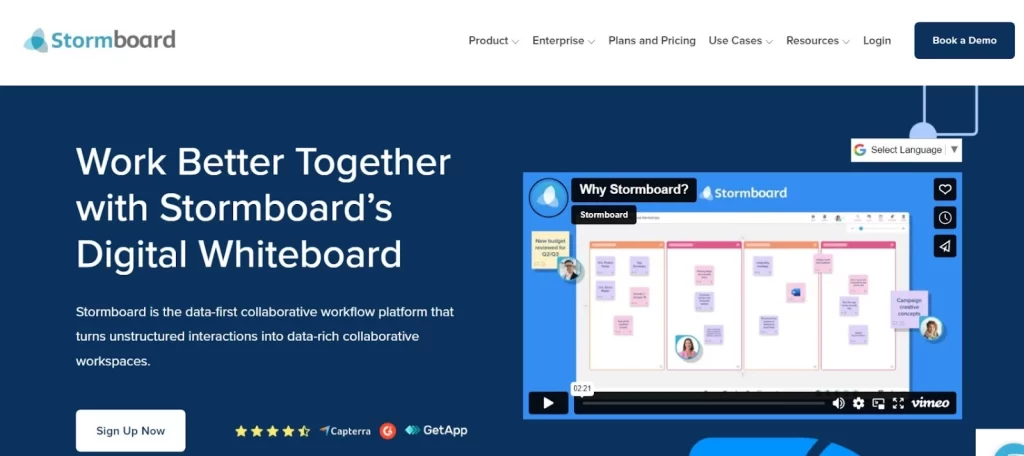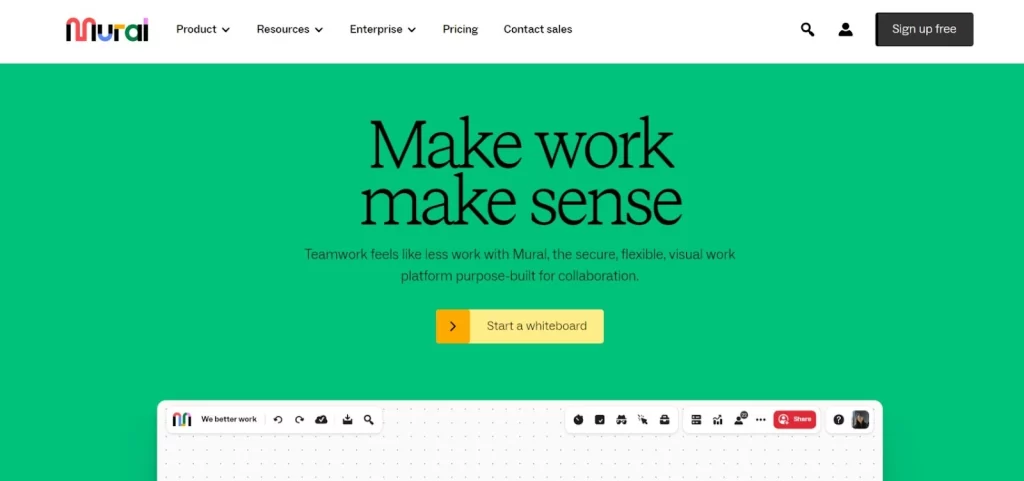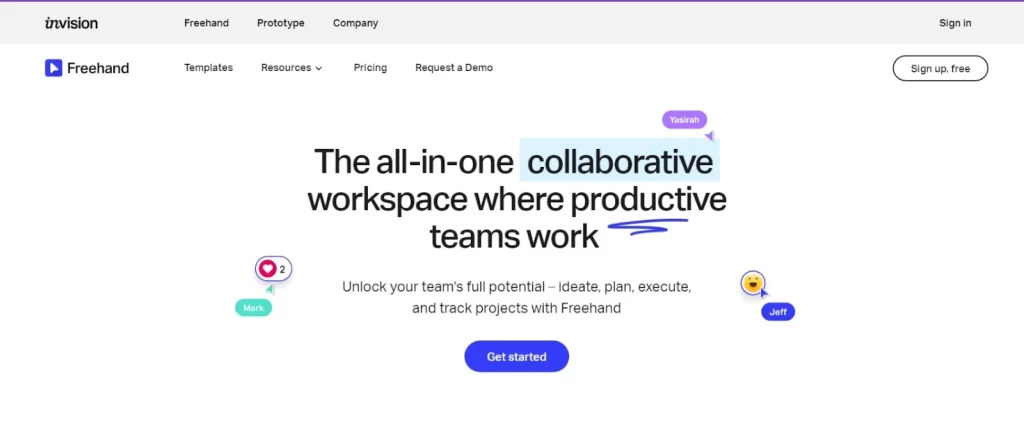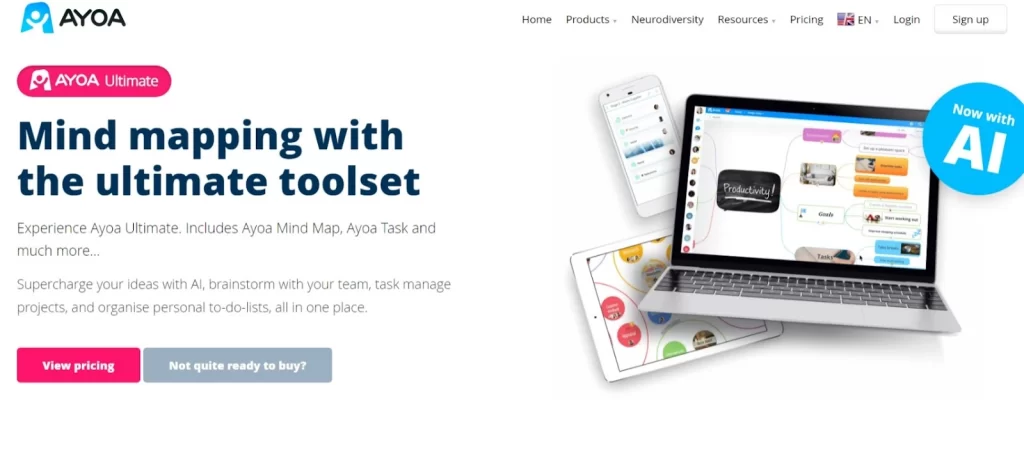- Online Whiteboard App Market Size
- What Is The Miro App?
- How Does An Online Whiteboard App Like Miro Work?
- Online Whiteboard App Advantages For Businesses
- Must-Have Features In An Online Whiteboard App Like Miro
- How To Develop An Online Whiteboard App?
- Cost Affecting Factors To Consider When Developing An Online Whiteboard App
- Online Whiteboard App Use Cases With Examples
- Top 5 Online Whiteboard Applications Like Miro In The Market Right Now
- Tech Stack To Consider For Developing An Online Whiteboard App
- Conclusion
- FAQ

As the landscape of remote work and digital collaboration expands, the need for intuitive and feature-rich whiteboard applications is increasing rapidly.
Online whiteboard apps like Miro are valuable tools for educators, trainers, and students. They facilitate interactive learning, allowing instructors to illustrate concepts, engage students in real time, and create a dynamic virtual classroom experience.
Creating an online whiteboard app represents an exciting business opportunity in collaborative technology, offering a dynamic platform for users to ideate, plan, and brainstorm in a virtual space.
In this guide, understand the crucial steps, features, and considerations necessary to bring your vision of an online whiteboard app to life.
- Online Whiteboard App Market Size
- What Is The Miro App?
- How Does An Online Whiteboard App Like Miro Work?
- Online Whiteboard App Advantages For Businesses
- Must-Have Features In An Online Whiteboard App Like Miro
- How To Develop An Online Whiteboard App?
- Cost Affecting Factors To Consider When Developing An Online Whiteboard App
- Online Whiteboard App Use Cases With Examples
- Top 5 Online Whiteboard Applications Like Miro In The Market Right Now
- Tech Stack To Consider For Developing An Online Whiteboard App
- Conclusion
- FAQ
Online Whiteboard App Market Size
Source: VerifiedMarketResearch
Entrepreneurs can tap into the profitable market of the online whiteboard app industry by satisfying the needs of a changing workplace, giving solutions for a range of sectors, and serving as a useful and adaptable tool for communication and collaboration.
A feature-rich and well-designed online whiteboard application can attract a large user base and produce steady income by successfully meeting these demands.
What Is The Miro App?
Miro is a whiteboard app that allows teams to collaborate and foster creativity. The platform has tools to help managers who lead the process from conception to execution. They may assign tasks, keep track of modifications made, and communicate with team members directly from the interface.
Also, by just turning on the screen sharing mode, all participants can see the screen while hearing the voice over the audio system of an individual representing the presentation.
Companies can add as many templates as they like to a board; they are not restricted to using just one. Additionally, customers may use their mouse, trackpad, or touchscreen to zoom and browse between the many templates on the board. From there, they can drag and drop objects, text, and sticky notes to add as required.
To extend the features even further, they can integrate the list of apps and can update Miro cards inside their Airtable base, for example, or add a voting plugin that allows users to vote on specific items.
Businesses can also automatically create a card on a board in Miro anytime they have a new task, need to submit a form, or need to enter data into a spreadsheet thanks to Miro’s Zapier connectors.
How Does An Online Whiteboard App Like Miro Work?
An online whiteboard tool offers a virtual workspace where users may communicate in real-time while exchanging concepts, drawings, and other visual materials. The general workflow for these programs is as follows:
1. User Registration and Authentication
To begin, users must register or connect to the online whiteboard application. Authentication guarantees that users can be properly identified and authorized by the platform.
2. Board Creation
Users can start a new whiteboard or join an already-existing one after logging in. Boards are virtual whiteboards where people may communicate and exchange material.
3. Real-Time Collaboration
Real-time collaboration is the main feature of online whiteboard applications. The same whiteboard can be accessed and edited concurrently by several individuals. One user’s changes are immediately mirrored for other users, creating a dynamic and engaging environment.
4. Drawing and Annotation Tools
Numerous drawing tools, such as pens, pencils, shapes, and text, are available in these apps. On the whiteboard, users may write, doodle, create diagrams, and annotate material.
5. Rich Media Integration
Rich material, including photos, movies, and documents, may frequently be integrated by users onto the whiteboard. This feature facilitates more thorough cooperation and improves the way ideas are represented visually.
6. Templates and Frameworks
Many online whiteboard applications offer pre-made frameworks and templates for typical use cases. Using these templates, users may quickly begin using structured boards for brainstorming, process mapping, and project planning.
7. Collaborative Editing Features
Users can edit and manipulate elements on the whiteboard collaboratively. This includes moving objects, resizing, and adjusting properties. Some platforms provide smart tools for recognizing and enhancing handwritten or drawn elements.
8. Commenting and Discussion Threads
Users may collaboratively alter and modify things on the whiteboard. This covers resizing, shifting, and changing the attributes of objects. Certain systems offer intelligent techniques to identify and improve handwritten or drawn items.
9. Real-Time Updates and Notifications
Real-time information regarding modifications on the whiteboard are sent to the participants. Notifications might contain details about the precise changes that were made as well as who made them.
10. Integration with Other Tools
Many online whiteboard applications may integrate cloud storage services, communication tools, project management systems, and other collaborative tools. Because of this, users may easily integrate the whiteboard into their larger workflow.
11. Security and Privacy Measures
Online whiteboard apps use techniques like encrypted communication, secure authentication, and occasionally the option for private or password-protected boards to guarantee data security and privacy.
12. Export and Share
Users may export the whiteboard’s information in several forms, including PDFs and picture files. Using a shareable link, they may also share the board with collaborators who aren’t registered users.
13. User Interaction Analytics
Certain systems include analytics functionalities that monitor how users engage with the whiteboard. This data may contain information about the individuals who contributed, the changed items, and the degree of overall participation.
Online Whiteboard App Advantages For Businesses
Online whiteboard apps offer several advantages that make them popular for various purposes, including collaboration, education, and business. Here are some of the key advantages:
1. Enhanced Collaboration and Remote Work
By offering a virtual environment where team members can collaborate in real time, exchange ideas, and brainstorm regardless of where businesses are in the world, an online whiteboard software promotes improved teamwork. This is especially important for distant teams and remote work since it simulates the feel of a real whiteboard where team members may graphically represent and refine ideas.
Visual contributions to discussions can be made by team members using drawing tools, shapes, and sticky notes. Updates in real-time ensure that everyone is aware of changes immediately, promoting dynamic and engaged teamwork. Moreover, commenting tools offer a forum for debate and criticism related to certain whiteboard components.
2. Better Creativity
An online whiteboard app’s visual format lets users visually represent ideas, which encourages creativity and makes brainstorming easier. Drawing, diagramming, and graphically organizing ideas is made possible by its dynamic canvas, making it an invaluable tool for designers, educators, creative professionals, and anyone interested in visual thinking.
Tools for Drawing and Annotation provides various drawing tools, including text, shapes, pencils, and pens, to allow for flexible concept expression. By highlighting, underlining, and emphasizing important areas, users using annotation tools can improve the readability of visual information.
Also, the platform allows for the integration of rich media assets, such as documents, videos, and photographs, enabling multimedia communication and creating mind maps, mood boards, design drawings, and other visual aids.
3. Real-Time Communication and Decision-Making
The online whiteboard app’s real-time collaboration features facilitate instant communication and decision-making. Team members can connect in real-time, eliminating the need for long email exchanges or other forms of communication to ensure that choices and debates are made quickly.
The ability for several users to collaborate on a single whiteboard simultaneously creates a real-time, dynamic environment for brainstorming and conversations. Cursor awareness features increase the sensation of presence by letting users see each other’s cursors in real-time.
4. Organized Information Sharing
Apps for online whiteboards are excellent in arranging and displaying data clearly and visually appealingly. This is very helpful for planning, teaching, and group projects that require communicating complicated information.
The platforms provide a range of frameworks and templates, including SWOT analysis, Kanban boards, and project deadlines, for various uses and encourage the exchange of knowledge in an orderly and systematic manner, particularly in professional and educational contexts.
Also, an online whiteboard enhances its functionality by adding interactive widgets and plugins. Users can boost the effectiveness of information conveyed by adding custom widgets, charts, and diagrams.
5. Wide Accessibility
Web browsers, desktop programs, and mobile devices may all access it, allowing people to work together across several platforms that let users interact with the whiteboard with their favorite gadgets, which promotes diversity.
The history of modifications made on the whiteboard may be tracked by users, offering insight into how concepts have changed over time. Also, activity logs make it easy to attribute ideas and modifications by helping to identify contributions.
Features like keyboard navigation, high contrast options, and screen reader assistance are all included in the online whiteboard. Guarantees that people with different skill levels may engage in cooperative activities on the whiteboard.
Must-Have Features In An Online Whiteboard App Like Miro
Miro is a popular online whiteboard tool known for its extensive features that support collaboration and creativity. To create an online whiteboard app similar to Miro, consider incorporating the following must-have features:
1. Digital Canvas
Online Whiteboard app offers a digital canvas that gives users plenty of room to brainstorm, organize, and see ideas come to life. Because of this canvas’ limitless scalability, intricate and sophisticated visual material may be produced.
2. Templates and Frameworks
There are a wide variety of templates and frameworks for different uses. Pre-built frameworks for tasks like mind mapping, user personas, agile workflows, project planning, and more are included in these templates. This function streamlines the process of developing certain visual materials.
3. Real-Time Collaboration
Collaborating in real-time is one of the best online whiteboard qualities. The same board may be used by several people at once, no matter where they are physically located, making it the perfect tool for collaborative workforces or remote teams.
4. Rich Media Integration
Users may add pictures, documents, and videos, among other types of material, to their boards. This feature makes ideas more visually appealing and enables groups to gather data from many sources in one convenient spot.
5. Drawing and Diagramming Tools
With the drawing tools available in whiteboard apps, users may make drawings, flowcharts, diagrams, and other visual components. These instruments facilitate the expression of ideas with both originality and accuracy.
6. Collaborative Editing and Contributions
Users can use features to add, edit, and move components on the board in real-time. Thanks to this collaborative editing tool, teams can build upon ideas in a dynamic and engaging environment.
7. Commenting and Mentioning
Users can add comments on some board elements, allowing for conversations and providing context. By mentioning someone in a remark, users may make sure that the appropriate team members are informed of any significant information that is said about them.
8. Integrations
Many third-party tools and services often used in project and company management are integrated with the online whiteboard app. This involves connections to well-known programs like Dropbox, Google Drive, Slack, Jira, and others.
9. Cross-Platform Accessibility
The online whiteboard app is accessible through web browsers, desktop applications (Windows, macOS), and mobile devices (iOS, Android). This ensures that consumers may collaborate by utilizing the gadgets of their choosing.
10. Activity Tracking and History
Users may monitor the history of changes made to the board, which provides insight into how ideas have evolved. This is a useful tool for monitoring contributions and understanding the status of a project.
How To Develop An Online Whiteboard App?
Developing an online whiteboard app involves several key steps, from planning and design to implementation and deployment. Here are detailed guides to help you through the development process:
1. Define Objectives and Use Cases
Briefly state the objectives of your online whiteboard application. Determine the target audience and the primary use cases. Whether it’s for remote collaboration, virtual education, or creative brainstorming, figuring out the app’s precise purpose will aid in feature development and design.
2. Plan the Feature Set
Based on the predetermined objectives, design the feature set of your online whiteboard application. Think of fundamental components like text entry, shapes, drawing tools, real-time teamwork, undo/redo options, and other advanced features supporting your goals. Features need to be prioritized based on user needs and implementation complexity.
3. Design User Interface (UI) and User Experience (UX)
Create a UI/UX design that is easy to use and aesthetically pleasing. Consider the overall layout, tool placement, and flow of the program. Provide a user interface (UI) that is responsive and works well on various devices, such as PCs, tablets, and smartphones. Test the product’s usability to ensure it is easy for users.
4. Choose the Technology Stack
Selecting an appropriate technology stack for your web whiteboard application is important. Consider the frameworks (Angular, React) if you are considering hybrid app development, the programming language (JavaScript, for example), and any additional tools or libraries needed for real-time functionality. Choose a solid backend solution for data storage, real-time collaboration, and user authentication, such as Firebase or WebSocket.
5. Implement Real-Time Collaboration
Real-time collaboration is necessary for an online whiteboard tool. Include features that allow several users to collaborate simultaneously on the same canvas. Utilise WebSockets and associated technologies to provide seamless communication and real-time updates. Address problems like dispute resolution and user presence indicators.
6. Integrate Multimedia Features
Incorporate multimedia capabilities to make your whiteboard app more interactive. Permit users to post documents, movies, and photos. Put annotation tools for multimedia components into practice. Ensure it works with popular file types and gives users an easy way to add various items to the whiteboard.
7. Implement Security Measures
Prioritise security to protect user data and offer a safe online environment. Implement secure user authentication protocols, enforce best practices for data privacy, and encrypt data transmission. Regularly update security protocols to address emerging threats and vulnerabilities.
8. Test and Iterate
Give your online whiteboard app a comprehensive examination. Check for security, usability, and functionality. To find and fix any problems, conduct end-to-end and unit testing. Obtain user input and make design and functionality revisions in response to testing outcomes.
Creating an accurate and accessible program requires constant testing and enhancement. Remember to follow development best practices, document your code, and think about scalability in case your user base grows. Plan for continuing updates and maintenance as well to handle any problems that could occur after launch.
9. Deploy your Whiteboard app
Decide on the hosting infrastructure for your online whiteboard app. Options include cloud services like AWS, Azure, or Google Cloud. Consider factors such as scalability, data storage, and server locations based on your target audience.
Implement a safe backup and disaster recovery plan. Regularly backup critical data and ensure that procedures are in place to recover the system in case of unexpected events quickly.
Create a continuous deployment pipeline to ensure that updates and enhancements are made frequently. This may be achieved by delivering new features, resolving problems, and optimizing performance in response to changing user needs and feedback.
Cost Affecting Factors To Consider When Developing An Online Whiteboard App
Several factors, such as the app’s complexity, functionality, technology stack, development team rates, and team location, can significantly affect the cost of creating an online whiteboard application. The following are significant factors that influence cost:
1. Design Complexity
The price may change depending on how complex the user interface (UI) and user experience (UX) design are. Developing a more complex layout may need more time, particularly if it includes intricate interactions or unique animations. A well-thought-out and intuitive user interface is essential to any application’s success. Costs will be impacted by the UI/UX design depth, the degree of interaction, and the requirement for a responsive design (one that can adjust to various devices). While engaging in a deliberate design approach might increase user satisfaction and engagement, it may also need further design and development work.
2. Scope and Features
The quantity and complexity of features greatly influence the cost of development. Applications with more sophisticated features, such as real-time collaboration, AI-powered capabilities, or connection with external tools, will cost more than basic online whiteboard apps with typical drawing tools and collaboration features. Basic features may include drawing tools, text input, and basic shapes, while advanced features could include real-time collaboration, multimedia integration, undo/redo functionality, and complex object manipulation. The more sophisticated the features, the more time and resources required for development.
3. Development Team
Development teams operate at a different pace. Employing a development team from an area with less development costs might result in lower costs than hiring teams from areas with higher development costs. But it’s crucial to balance price, skill, and quality.
4. Integration with External Services
Complexity and expense may increase if your whiteboard app interacts with external resources like cloud storage, project management software, or authentication providers. Suppose you plan to integrate your online whiteboard app with other tools or platforms, such as project management software, cloud storage, or communication tools. In that case, the complexity of these integrations will affect costs. Compatibility issues, API development, and ensuring a seamless user experience across different ecosystems can contribute to development expenses.
5. Cross-Platform Compatibility and Tech Stack
Consider if you want to be compatible with many platforms (web, mobile, tablet) or whether your online whiteboard software will be designed for a single platform (e.g., web only). Cross-platform development is more challenging as there may be differences in needs and design concerns between platforms. Although they may impact pricing, frameworks like React Native or Flutter can simplify cross-platform development.
Additionally, the libraries, frameworks, and technologies used may affect development expenses. While some technologies may require licensing fees, others require more development time.
Online Whiteboard App Use Cases With Examples
Whether fostering collaboration among remote teams, enhancing virtual education, promoting creative thinking, managing projects, or facilitating online tutoring, online whiteboard apps offer many professional and educational scenarios. The major use cases of online whiteboard apps are as follows:
1. Virtual Education and Remote Learning
In online learning environments and virtual classrooms, online whiteboards are commonly used. These platforms allow teachers to facilitate interactive classes, provide visual explanations of difficult ideas, and generate real-life conversations among students. Teaching a wide range of courses is made easier by the tool’s sketching capabilities and multimedia integration.
Example: Blackboard Learn
A feature-rich learning management system (LMS) that helps schools manage online courses and support remote learning. It gives teachers a virtual platform to prepare and present lesson materials, interact with students, and oversee evaluations. Many universities, colleges, K–12 schools, and other educational institutions have embraced Blackboard Learn.
Adaptive learning technologies are included in some Blackboard Learn versions. These resources allow teachers to tailor the curriculum to each student’s needs, learning preferences, and performance.
2. Project Planning and Management
Online whiteboards are useful for work management, project planning, and timeline visualization by project teams. The generation of Gantt charts, Kanban boards, and other project management visualizations is made easier by the interactive nature of these technologies. This improves coordination, communication, and the effectiveness of the project as a whole.
Example: Trello
Trello is a well-known program for project management and teamwork that helps people and teams prioritize and organize activities using a card/board model. It is particularly popular for agile development, content planning, and task management as it offers a versatile and graphical approach to project management.
3. Remote Collaboration and Team Meetings
When working remotely and needing to communicate in real time, online whiteboard apps come in quite handy. Teams may collaborate virtually on tasks like creativity, project planning, and strategy discussions by using the digital canvas. The quality of virtual meetings is improved by the ability to annotate, draw on, and share papers.
Example: Microsoft Whiteboard
With Microsoft Whiteboard, users can brainstorm, create, and collaborate in real time using a digital canvas application. Microsoft Whiteboard is appropriate for remote teams and virtual meetings since it enables real-time user collaboration. The digital canvas allows for simultaneous contributions from several users, and all users instantaneously see the modifications made.
4. Online Tutoring and Virtual Workshops
Teachers, tutors, and workshop leaders have an evolving platform to conduct virtual sessions using online whiteboards. Tutors can use the sketching and annotation tools to interact with students, solve difficulties, and clarify topics. Information may be presented graphically in workshops and training sessions, which promotes understanding and active involvement.
Example: Concept Board
A digital canvas that teams can use to discover ideas and collaborate on different projects is provided by the online collaboration tool Conceptboard. It’s designed to facilitate visual collaboration, making it suitable for brainstorming, online tutoring, and virtual workshops.
5. Brainstorming and Ideation Sessions
Online whiteboards are mostly used for creativity and brainstorming. Teams can work together to produce and visualize ideas, make mind maps, and arrange ideas aesthetically pleasingly. Problem-solving sessions may be lively and creative due to the versatility of the digital canvas.
Example: Lucid Spark
Lucidspark provides a digital canvas where teams can collaborate in real time. The infinite canvas allows users to capture ideas and create mind maps, diagrams, and other visual representations. The platform allows users to create collaborative workspaces for different projects or topics. Each workspace has its own digital canvas, templates, and a set of collaborators.
Top 5 Online Whiteboard Applications Like Miro In The Market Right Now
There are several online whiteboard applications popular for collaboration, education, and brainstorming. The following applications offer various features for virtual collaboration, ideation, and project planning. The top 5 online whiteboard applications like Miro in the market are as follows:
1. Stormboard

An ideation tool similar to sticky notes lets users toss notes or index cards containing text, images, and even videos onto various board areas.
The digital sticky note comes with its own whiteboard, so users may begin adding ideas and transform any sticky note into a collaborative whiteboard that all participants can edit and view in real-time.
Stormboard allows board participants to vote, text chat, issue tasks, and place notes around the board using a mouse. Businesses may resolve significant issues during brainstorming sessions or collaborative meetings, like storing iterations for future review and revision.
| Founded in | 2009 |
| Founded by | Reg Cheramy |
| Industries | Collaboration, Enterprise Software, SaaS, Small and Medium Businesses, Software, Telecommunications |
| Headquarters | Edmonton, Alberta, Canada |
2. Limnu

Limnu enables multiple users to work on the same whiteboard simultaneously, providing a platform for real-time collaboration and simplifying the online working experience.
When users click the share icon and copy and paste the URL, it invites others to visit the board they have made. Moreover, only users can restrict their ability to observe. Several of the platforms and gadgets that can be used to access the platform include web browsers, tablets, and smartphones.
Moreover, the platform also integrates with other collaboration tools and platforms to enhance the overall workflow. This includes integrations with video conferencing tools, project management software, or cloud storage services.
| Founded in | 2015 |
| Founded by | Andrew Kunz |
| Industries | Enterprise, Software |
| Headquarters | Salt Lake City, Utah, United States |
3. Mural

Users of the mural platform can resize and rearrange the whiteboards as desired. They can also pick from various templates to add pre-built grids and content boxes for more structure or leave each whiteboard with its default blank white backdrop.
Businesses can add pre-built grids and content boxes for more structure by selecting from a selection of themes. Several designs provide comprehensive tutorials and helpful tips, making it easy to begin using Mural. Users can also designate rooms for different projects.
Moreover, the platform also integrates with Zapier, letting users automatically create new tasks in their project management tool based on their whiteboards or create new Mural stickies based on form submissions.
| Founded in | 2011 |
| Founded by | Agustin Soler, Mariano Battan |
| Industries | B2B, Collaboration, Enterprise Applications, Enterprise Software, Product Design |
| Headquarters | San Francisco, California, United States |
4. Invision Freehand

InVision Freehand is a collaborative online whiteboarding tool developed by InVision. A platform is well-known for its design and prototyping tools catering to designers, product managers, and other stakeholders involved in product development.
Users can sync their Sketch, Photoshop, and Figma files, create mockups using the built-in wireframes and get real-time feedback from teammates and stakeholders.
Also, the platform allows multiple users to collaborate in real-time on a shared digital canvas. It is particularly useful for teams working remotely or across different locations where users can leave comments directly on the canvas, making it easy to provide feedback or discuss specific design elements.
| Founded in | 2011 |
| Founded by | Ben Nadel, Clark Valberg |
| Industries | Apps, Collaboration, Internet, Mobile, Product Design, SaaS, Software, UX Design |
| Headquarters | Greater New York Area, East Coast, Northeastern US |
5. Ayoa Ultimate

Users with Ayoa Ultimate can create mind maps to visually organize ideas, concepts, and tasks for brainstorming and outlining plans.
OpenGenius created the productivity and collaboration platform Ayoa. It incorporates several functionalities, such as collaborative whiteboarding, task management, and mind mapping, to assist individuals and groups in creativity, planning, and project implementation.
Also, the platform offers integrations with other popular tools and platforms to streamline workflows. This might include integrations with communication tools, file-sharing services, or project management software.
| Founded in | 2019 |
| Founded by | Chris Griffiths |
| Industries | Collaboration, Productivity Tools, Project Management, SaaS |
| Headquarters | Europe, Middle East, and Africa (EMEA) |
Tech Stack To Consider For Developing An Online Whiteboard App
Developing an online whiteboard app requires a combination of tools for different aspects of the development process, including design, coding, collaboration, and deployment. Here the tech stack you might consider using:
1. Development Environment
- Visual Studio Code
- Sublime Text
- Atom
2. Version Control
- GitHub
- GitLab
- Bitbucket
3. Frontend Development
- React
- Vue.js
- Angular
4. Backend Development
- Node.js
- Django
- Flask
- Ruby on Rails, or Spring
- WebSocket Library
5. Database
- MongoDB
- PostgreSQL
- MySQL
6. Real-Time Collaboration
- Socket.IO
- Pusher
- Firebase Realtime Database
7. User Authentication
- Auth0
- Firebase Authentication
- Passport
8. Frontend Design
- Sketch
- Figma
- Adobe XD
9. Project Management
- Jira
- Trello
- Asana
10. Drawing Library
- Fabric.js
- Konva.js.
11. Integrated Development Environment (IDE)
- WebStorm for JavaScript/Node.js
- PyCharm for Python
- IntelliJ for Java
Conclusion
Developing an online whiteboard app like Miro requires a strategic approach that combines innovative features, seamless collaboration capabilities, and an intuitive user interface. As collaborative work environments evolve, the demand for digital tools that facilitate remote teamwork and creative brainstorming has grown significantly.
From real-time collaboration features enabling multiple users to work together seamlessly to a diverse set of drawing tools catering to various creative needs, building a successful online whiteboard app involves carefully considering user experience, functionality, and innovation.
Therefore, it makes a wise decision to work collaboratively with a reliable app development company with extensive experience developing online whiteboard apps like Miro.
Contact us right now to hire a developer, design the best solutions for your business, and start driving the company to new heights.
Our development team will analyze the needs of your business in-depth before making recommendations and developing an online whiteboard app like Miro.
Get in touch with us right now to learn more about how our development services may assist you in starting and growing your company.
FAQ
Q. How to develop an online whiteboard app?
A. An online whiteboard app can be developed by following the development steps: define whiteboard app objectives and use cases, plan the app feature set, design user interface (UI) and user experience (UX), choose the technology stack, implement real-time collaboration, integrate multimedia features, implement security measures, test, and iterate, deploy your whiteboard app.
Q. What are essential features to have in a whiteboard app?
A. An online whiteboard app must have a set of essential features such as digital canvas, templates and frameworks, real-time collaboration, rich media integration, drawing and diagramming tools, collaborative editing and contributions, commenting and mentioning, integrations, cross-platform accessibility, activity tracking, and history.
Q. How can businesses benefit from an online whiteboard app?
A. Enhanced collaboration and remote work, better creativity, real-time communication and decision-making, organized information sharing, and wide accessibility are some business benefits of an online whiteboard app.
Q. How much does it cost to develop an online whiteboard app?
A. The cost of developing an online whiteboard app depends on design complexity, project scope, features, development team, integration with external services, cross-platform compatibility, and tech stack.













Gaurav Patil